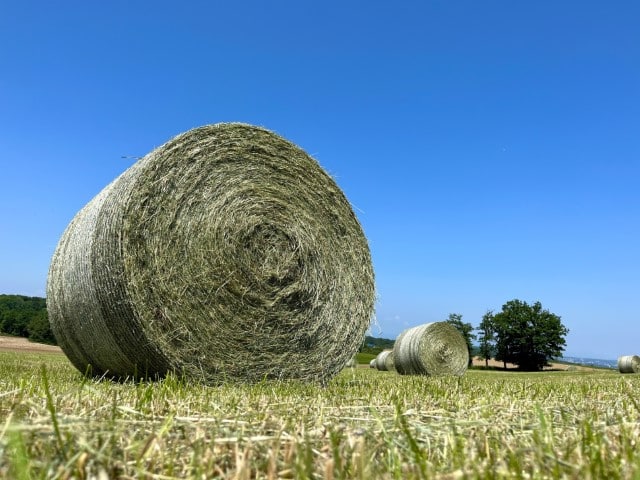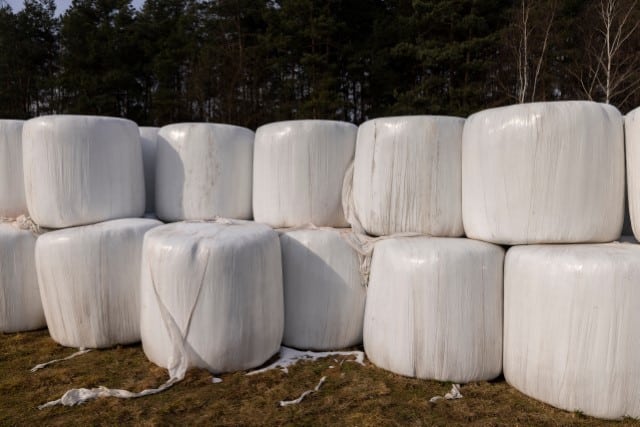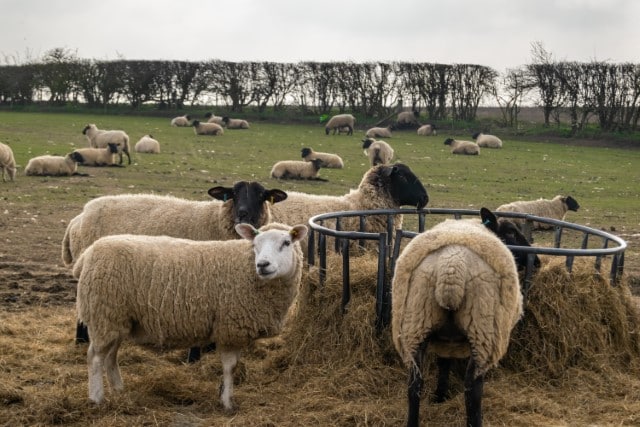If you’re new to sheep farming, you need to know the difference between haylage and dry hay. These two food sources differ in how they are made and stored. In today’s post, I’ll compare haylage vs hay and reveal everything you need to know, including how the nutritional value of haylage compares to hay for sheep.
The information I’ll go over here will help you understand the benefits and drawbacks of each of these food sources for your flock.

Let’s start with the basics.
Haylage vs Hay Comparison
Here’s a useful haylage vs hay comparison chart for your quick reference.
| Haylage | Hay |
|---|---|
| Haylage should be between 50 and 75 percent dry matter content before you ensile it. | Hay must be at least 85 percent dry matter content before you put it in bales. |
| Haylage must be wrapped in layers of a special plastic wrap, to keep out oxygen. | Hay is simply put into bales. |
| You will have to wait at least six weeks after making haylage before feeding it to your animals. That is because it takes a minimum of six weeks for the correct fermentation process (which is essential for proper preservation) to take place. | You can feed hay to your animals right after it is made and baled, as long as there isn’t any heating in the bales. |
Now let’s explore the differences between hay and haylage in a little more detail.
How are Hay and Haylage Made?
Both hay and haylage are made of grass, but they differ in how they are prepared and then later stored.

How Hay is Produced
If a producer is making hay, they will cut the grass when it is mature and then leave it to dry in a field before putting it in bales. They will store it after that.
It’s essential that the hay is left to get dry enough before putting in bales. If this doesn’t happen, it will be at real risk of becoming moldy and spoiled.
You should make sure that the hay is at least 85 percent dry matter before putting it into bales.
Making hay is difficult if the weather doesn’t cooperate. For example, if there is constant rain, this will be impossible to achieve.
How Haylage is Produced
If you want to make haylage instead, you will usually cut it earlier on in the season. You will then leave it to wilt for a limited period of time in a field.

After that, you will bale it and then wrap it in plastic. Several layers of special plastic wrap must be used.
RELATED: Haylage vs Silage Comparison (key differences explained)
How Are Hay and Haylage Stored?
As hay and haylage are prepared differently, they must be stored and preserved differently.
How to Properly Store Hay
With hay, there has to be as little moisture as possible so that it can be properly preserved without growing mold.
If hay is too moist, it will get moldy and won’t be suitable for use.
How Haylage Storage Differs from Hay
With haylage, it is the exclusion of oxygen that preserves the hay. That is because oxygen is needed for mold growth.

When you get haylage, it is usually somewhere between 50 and 70 percent dry matter. Many producers have recently started to try to create drier versions of haylage.
In some cases, the haylage is dry enough even to think about calling it “wrapped hay.”
It may seem counterintuitive, but you will have to be careful when getting very dry haylage.
This is because when the farmer tries to wrap very coarse and dry material in a way that will exclude oxygen, he or she will likely be unsuccessful.
There will likely be air pockets within the bale, and these air pockets will quickly cause the haylage to spoil.
This is why very dry haylage tends to be especially likely to grow mold or get spoiled before use.
Comparing the Nutritional Value of Haylage vs Hay
If you ever choose to feed your animals haylage, you will likely have to give them more of the food. That is because the moisture content will make it heavier than hay.

You will have to give each animal more haylage per pound of their body weight than you would have to give them of hay.
The type of grass and maturity of the grass that is used for making hay or haylage are the primary factors that affect nutritional differences. Whether you make the grass into hay or haylage makes very little difference.
There are certain nutrients that don’t really change their levels by preservation method and are really determined by grass type and the grass’s maturity when harvested.
Some of these nutrients are NDF (a measure of fiber) and many minerals.
Key Difference Between Hay and Haylage
The main nutritional difference created by preservation method lies in water soluble carbohydrate (WSC). Water soluble carbohydrates reflect the simple sugars as well as fructans.

Haylage needs to be meticulously preserved in the right way for the correct amount of fermentation to take place.
This process consumes the sugar and makes it into a different kind of energy called volatile fatty acids. Volatile fatty acids bring down the sugar level.
It may seem strange, but you will also have to think about respiratory health when considering haylage and hay. Hay has more respirable particles than haylage.
These particles are so small that you won’t be able to see them, and the elements of them can potentially harm animal health. For example, there could be bacteria and mold spores.
There is something you can do to help resolve this issue. Use a hay steamer to steam the hay.
Alternatively, you can use a high temperature dried forage replacer.
When Can You Use Hay or Haylage that You Have Made this Year?
If you have made any hay or haylage this year (or you are thinking about buying such hay or haylage), you need to know whether this is correct or how long you should wait to feed animals this forage.
When Can You Feed Hay to Sheep?
You can usually give hay that has been made and stored this year to your animals immediately.

There is only one exception to this: if there is any heating in the hay bales.
As long as you don’t find any heating in the hay, you can feed it to your animals right away.
Your animals will benefit from a higher level of nutrients than they would get otherwise. Remember, vitamin strength tends to decrease over time.
You Have to Wait Longer with Haylage
If you are using haylage instead, you will usually have to wait approximately six weeks or longer.
That is because you need to wait for the correct fermentation process to occur. This is necessary for you to know that the hay is correctly preserved.
Remember whenever you make any changes in your animals’ food, you should do so gradually over about two weeks.
It’s best to mix the old forage together with the new forage, adding progressively more of the new forage as you go.
Is Haylage or Hay Better For Sheep?
While both haylage and hay can play a part in your flock’s diet, haylage has the advantage.

The reason haylage is better than hay is the fact that it’s easier for sheep to digest.
Remember, sheep are ruminants. This means that their stomachs have four compartments.
When a ruminant eats regular dry hay, their stomach’s second compartment has to ferment it.
By contrast, if a sheep eats haylage, it doesn’t need to do this. That is because haylage is fermented before it is eaten.
As a result, its nutrients are absorbed more easily, and there isn’t as much strain on the digestive system.
Final Thoughts: Haylage vs Hay
As I’ve explained here, there are big differences between haylage and hay.
Haylage needs to be protected from the air, so you need to wrap it in a special plastic wrap to store it. Hay, on the other hand, is just stored in bales and exposed to the air.
When it comes to nutrition for your flock, haylage is preferable to hay. But remember that whichever one of these you offer, it’s only one part of a complete diet.
While you’re here, take a moment to learn more about your flock’s nutritional needs in my Sheep Nutrition Guide.

